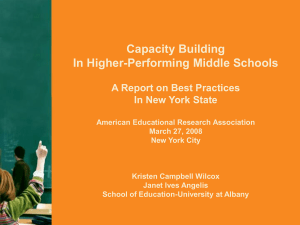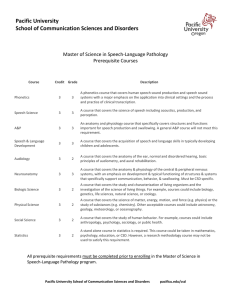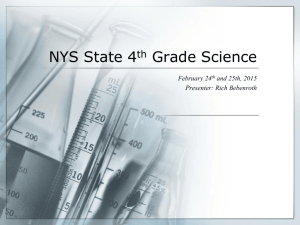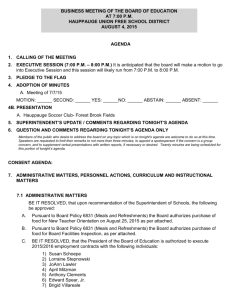Janet Angelis Kristen Campbell Wilcox University at Albany
advertisement
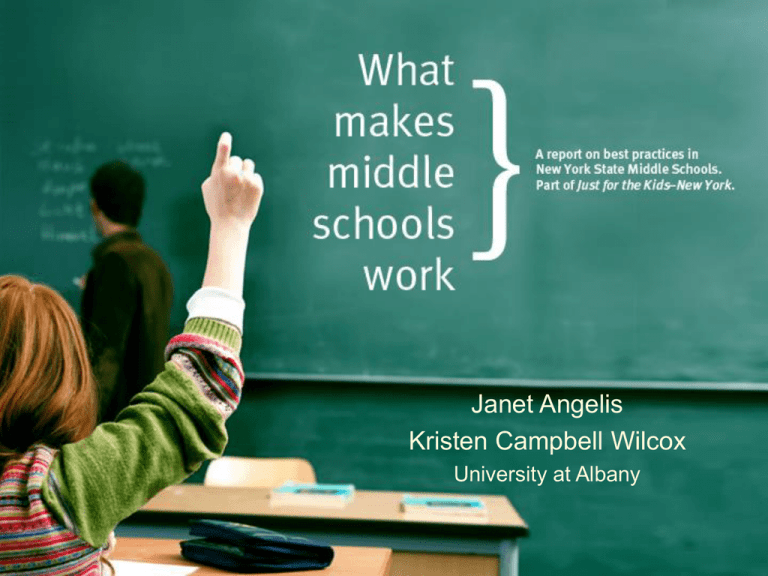
Janet Angelis Kristen Campbell Wilcox University at Albany Agenda 1. 2. 3. 4. 5. 6. Overview (15) How do I think my school is doing? (10) Learning from each other (20-30) Learning from the study (10) How do we think our school/district is doing? (10) Planning next steps (10-20) •5 Key Elements Relationships Lay the Foundation Trust and respect make possible… security and well-being for students and faculty; constant collaboration; honest evaluation of results and adjustments; the development and enactment of a shared vision. The Project and the Study • National • State comparable best practices • Just for the Kids-NY Our Sample • 10 consistently HP schools with 6 similar but consistently APs, based on 3 years of NYS Assessment data (2003-5) • Half: = or > NYS average poverty level • Urban, rural, suburban • Open admissions • NYS average per pupil expenditures 10 Higher Performers The Schools • • • • • • • • • • J.T. Finley - Huntington UFSD Holland - Holland CSD John F Kennedy - Utica CSD A. Leonard - CSD of New Rochelle Niagara - Niagara Falls CSD Port Chester - Port Chester-Rye UFSD Queensbury - Queensbury UFSD Vernon-Verona-Sherrill - Sherrill CSD West - Binghamton CSD Westbury - Westbury UFSD For a case study of each school: www.albany.edu/aire/kids And Analysis The data • 2-day site visits • Interviewed teachers and administrators using survey questions provided by JFTK • Collected documents • Analyzed and wrote a case study for each site • Cross-site analysis 5 Key Elements Findings Relationships Lay the Foundation Trust and respect make possible… security and well-being for students and faculty; constant collaboration; honest evaluation of results and adjustments; the development and enactment of a shared vision. Each necessary; not sufficient alone or w/ 1-3 others. Trust • Respect for and from all • Clear expectations of students • Shared responsibility I feel totally comfortable to talk about concerns with the principal. When the principal comes into my classroom -we have strong support and trust. We can’t do it alone . . . Parents are involved here. Trust The single most important thing . . . is to build trust with your faculty. • Deliberate and planned • “Family” • Provides safety to disagree, to share challenges, even failures Social & Emotional Well-Being • Its lack interferes with learning • Connect with every student: teaming, looping, “guide rooms,” activities, and social services; special attention for those at risk • Transitions: ES – MS; MS – HS • Safety, security, and diversity We use social emotional learning to focus on what’s common among us and not on what is different. Collaborative Conversations • Purpose: student learning and achievement - collectively and individually • Consistent, expected, and frequent • Scheduled and unscheduled • Teams and committees - within and across grades and subjects - within, across, and outside of school Collaboration You need to work as a team; there’s nothing a teacher can accomplish alone. We communicate from one grade to the next. We respect teachers in the grades below. Evidence-Based Decision Making • Multiple sources - student performance data - teacher experience - teachers and administrators - students, parents, and community - adopted programs • Ongoing and acted on • Focus beyond the state assessments: standards Evidence-Based Decision Making We invite students back after a semester or two at college and ask what was most helpful . . . [and not] so helpful. [The school improvement model we chose] expects teachers to make professional choices. We analyze the state exam -kid by kid -- question by question. Shared Vision • • • • • Raising learning and achievement for all students Built by all Clearly articulated Echoed from central office to classroom Never done You never arrive, you are always becoming. It’s a goal without a finish line. Agenda 1. 2. 3. 4. 5. 6. Overview (15) How do I think my school is doing? (10) Learning from each other (20-30) Learning from the study (10) How do we think our school/district is doing? (5) Planning next steps (10-20) Agenda 1. 2. 3. 4. 5. 6. Overview (15) How do I think my school is doing? (10) Learning from each other (20-30) Learning from the study (10) How do we think our school/district is doing? (5) Planning next steps (10-20) Fishbowl: Learning from each other • Why did you rank your school/district as doing very well on this element? • What are some of the steps that were taken/are being taken? Agenda 1. 2. 3. 4. 5. 6. Overview (15) How do I think my school is doing? (10) Learning from each other (20-30) Learning from the study (10) How do we think our school/district is doing? (5) Planning next steps (10-20) www.albany/edu/aire/kids • Case studies of the HP middle and elementary schools • Best Practice Framework for middle and elementary schools, with detail and samples of evidence • Cross-site reports for middle and elementary schools • 4-page summary of the middle school results • Link to the national site Agenda 1. 2. 3. 4. 5. 6. Overview (15) How do I think my school is doing? (10) Learning from each other (20-30) Learning from the study (10) How do we think our school/district is doing? (5) Planning next steps (10-20) Agenda 1. 2. 3. 4. 5. 6. Overview (15) How do I think my school is doing? (10) Learning from each other (20-30) Learning from the study (10) How do we think our school/district is doing? (5) Planning next steps (10-20) JFTK-NY cf. NYS Essential Elements JFTK-NY • Relationships • Emotional Well-Being • Collaboration • Evidence-Based Decision Making • Shared Vision NYS Essential Elements Basic goals • Intellectual development/academic achievement of all students • Personal and social development of each student JFTK-NY cf. NMSA This We Believe JFTK-NY NMSA This We Believe • Relationships Culture Matters: • Emotional Well-Being • Collaboration • Collaboration • Shared vision • Evidence-Based Decision • Safe environment Making • High expectations for all • Shared Vision • Adult advocate for every student Jigsaw on the 5 Elements • Count off by 5’s • In your groups, read the element that corresponds with your number • Discuss what features, practices, beliefs seem prevalent re: that particular element • Prepare to report out to the whole group on the most important aspects of that element
